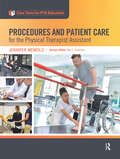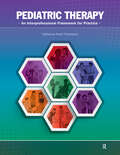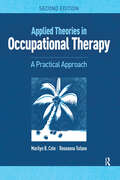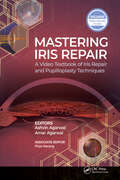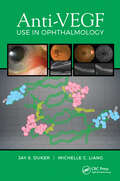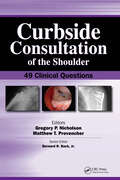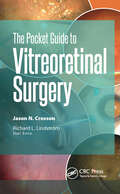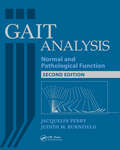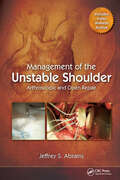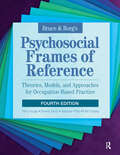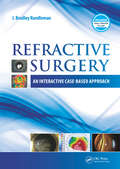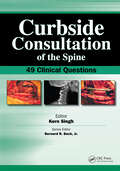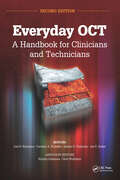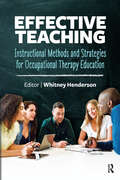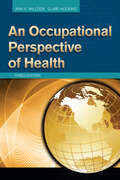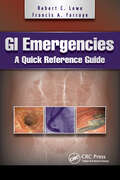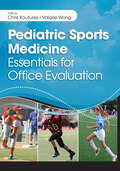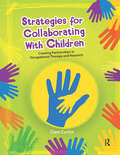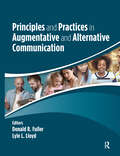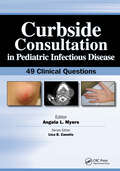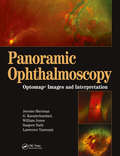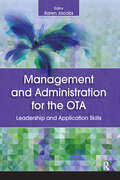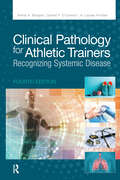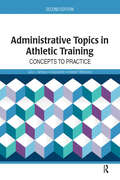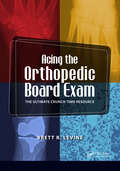- Table View
- List View
Procedures and Patient Care for the Physical Therapist Assistant (Core Texts for PTA Education)
by Jennifer MemoloProcedures and patient care will be one of the first courses a physical therapist assistant (PTA) student will encounter as they begin their educational career. The foundational material covered in Procedures and Patient Care for the Physical Therapist Assistant includes information about transfers, positioning, vital sign measurement, wheelchair fit and management, assistive devices, and gait. These skills are vital to know as a PTA, regardless of specialization or location of employment.Inside Procedures and Patient Care for the Physical Therapist Assistant, Jennifer Memolo includes objectives, key terms, common abbreviations, and review questions. Also, in each chapter is information adhering to the current best practice and an understanding of red flags a PTA should know and report to supervising physical therapists or other health care providers.This text stands out from others because it is catered specifically to PTA students rather than the generalized health care practitioner. It can be used throughout the student’s education as a reference since all other courses build upon and cycle back to this core information. It can also be utilized even after graduation as preparatory material for the board examination or as a refresher for the practicing clinician.Included with the text are online supplemental materials for faculty use in the classroom.Procedures and Patient Care for the Physical Therapist Assistant provides core information that the PTA will use and build upon throughout their entire career which is what makes it a suitable text for students, faculty, and clinicians.
Pediatric Therapy: An Interprofessional Framework for Practice
by Catherine Rush ThompsonResearch has become increasingly clear regarding the benefits of interprofessional collaborations in health care. Pediatric therapists have long recognized that coordinated care and advocacy for children and their families promote healthy growth, development, and participation in a wide range of environments. To this end, Pediatric Therapy: An Interprofessional Framework for Practice has been designed to engage students and clinicians in interprofessional learning experiences that cultivate collaborative practice and optimize the outcomes of those served. Dr. Catherine Rush Thompson and her team of contributors represent years of experience across the fields of physical therapy, occupational therapy, and speech-language pathology. Rather than discussing each of these fields in isolation, however, the text explores professional roles and responsibilities, emphasizing essential skills needed for collaboration in a range of pediatric settings.Key Interprofessional Concepts Covered: Foundations and philosophies that serve as a basis for pediatric care Assessing infants, children, youth, and adolescents in various situations Legal and ethical considerations impacting pediatric care Unique issues encountered in settings where pediatric therapies are offered Using current evidence and the clinical reasoning process for designing and modifying interventions Each section of Pediatric Therapy offers case-based learning activities requiring interprofessional collaboration for clinical reasoning to optimize care. This approach encourages an appreciation of the importance of holistic care, as well as an understanding of the roles, frames of reference, and approaches favored by each discipline. Pediatric therapists and others who work in healthcare and educational settings will appreciate Pediatric Therapy: An Interprofessional Framework for Practice as a guide for developing the interprofessional competencies needed to achieve desired outcomes for children and their families.
Applied Theories in Occupational Therapy: A Practical Approach
by Marilyn B. Cole Roseanna TufanoApplied Theories in Occupational Therapy: A Practical Approach, Second Edition provides a system-based, comprehensive overview of the theories, models, and frames of reference that influence occupational therapy around the world. Esteemed authors Marilyn B. Cole and Roseanna Tufano have updated their foundational text with an evidence-based focus derived from their experiences of more than 30 years teaching theoretical content to students. Applied Theories in Occupational Therapy: A Practical Approach, Second Edition offers practical templates to help readers learn the key constructs of each theory and assimilate knowledge based on Mosey’s organizational structure. Each theory-based chapter is designed for ease in gathering content knowledge and comparing theories in a distinctive manner. The book includes: Summaries of the current trends found in practice, along with external influential models of health and wellness impacting populations of concern Exploration of some of the most common occupation-based models around the world. Each model’s holistic conceptual nature is described, including theoretical assumptions and practice guidelines for evaluation and intervention Reviews of common frames of reference found in evidence-based practice, which address the secondary and tertiary needs of common populations In this Edition, learning activities and case-based analyses strengthen the application of theory into current practice contexts. Practical guidelines assist the reader in formulating an evaluation process and determining the relevant intervention strategies that promote occupational participation, engagement, and functioning across the lifespan and the continuum of health.Included with the text are online supplemental materials for faculty use in the classroom.
Mastering Iris Repair: A Video Textbook of Iris Repair and Pupilloplasty Techniques
by Ashvin Agarwal Amar AgarwalThe first of its kind on this topic, Mastering Iris Repair: A Video Textbook of Iris Repair and Pupilloplasty Techniques combines practical explanations with dynamic surgical videos and animations, perfect for specialists as well as general ophthalmologists.Together with top surgical experts, Drs. Ashvin Agarwal, Amar Agarwal, and Priya Narang have created an accessible text filled with high-yield information that provides essential coverage of the most recent innovations in iris repair. With appeal for subspecialty areas such as cornea, glaucoma, cataract, and retina, this book identifies abnormalities that are regular challenges for the ocular surgeon. Nearly 200 figures are accompanied by more than 4 hours of new, original instructional video and animation with narration hosted on a companion website.Mastering Iris Repair is divided into 3 sections to provide quick access in a comprehensive resource: Iris repair techniques: Single-pass four-throw pupilloplasty, McCannel and Siepser suturing techniques, different types of sutures, and repair management Special topics: Pinhole pupilloplasty, pupilloplasty in special indications, iris prosthesis, and complications of iris repair and pupilloplasty Extended implications of iris and pupil repair: Iris cosmetics devices, how devices manipulate iris tissue, and intraocular lenses affected by iris repair techniques Abundantly referenced and supplemented by evidence-based cases, Mastering Iris Repair: A Video Textbook of Iris Repair and Pupilloplasty Techniques enhances surgical potential for all ophthalmologists.
Anti-VEGF Use in Ophthalmology
by Jay Duker Michelle LiangThe introduction of anti-vascular endothelial growth factor (VEGF) agents has revolutionized therapy for a host of ocular diseases associated with leakage from normal blood vessels and pathologic blood vessel growth. Anti-VEGF Use in Ophthalmology is an all-inclusive reference designed to provide detailed, up-to-date, and clinically relevant information on the current use of anti-VEGF agents in the treatment of all ocular conditions. Drs. Jay S. Duker and Michelle C. Liang have assembled a prestigious group of contributors who pool their collective expertise in this comprehensive book. Anti-VEGF Use in Ophthalmology is split into two sections with the first providing the history of VEGF and an overview of anti-VEGF agents and different routes of drug delivery, as it is important for eye care providers to be familiar with up-to-date aspects of the medications and indications for use. The second section details the clinical uses of anti-VEGF agents in numerous ocular diseases, from the anterior segment including cornea and glaucoma to uveitis and various retinal and choroidal diseases. Each chapter in this section summarizes the disease process and utilizes high-quality ocular imaging to demonstrate the therapeutic use of the anti-VEGF agents. Some of the topics covered in Anti-VEGF Use in Ophthalmology: Neovascular Age-Related Macular Degeneration Proliferative Diabetic Retinopathy Retinal Vein Occlusion Uveitis Neovascular Glaucoma Macular Edema Retinopathy of Prematurity Corneal Disease Anti-VEGF Use in Ophthalmology combines the theory and applications of anti-VEGF agents, making it not only a great learning tool for beginners but also a useful reference tool for a wide range of eye care professionals including optometrists, residents, comprehensive ophthalmologists, as well as specialists in anterior segment, pediatrics, and vitreoretinal disease.
Curbside Consultation of the Shoulder: 49 Clinical Questions (Curbside Consultation in Orthopedics)
by Matthew Provencher Gregory NicholsonAre you looking for concise, practical answers to those questions that are often left unanswered by traditional shoulder references? Are you seeking brief, evidence-based advice for complicated cases or controversial decisions? Curbside Consultation of the Shoulder: 49 Clinical Questions provides quick answers to the thorny questions most commonly posed during a “curbside consultation” between orthopedic surgical colleagues.Drs. Gregory P. Nicholson and Matthew T. Provencher have designed this unique reference which offers expert advice, preferences, and opinions on tough clinical questions commonly associated with the shoulder. The unique Q&A format provides quick access to current information related to the shoulder with the simplicity of a conversation between two colleagues. Numerous images, diagrams, and references are included to enhance the text and to illustrate the management of shoulders.Curbside Consultation of the Shoulder: 49 Clinical Questions provides information basic enough for residents while also incorporating expert advice that even high-volume clinicians will appreciate. Practicing orthopedic surgeons, orthopedic residents, and medical students will benefit from the user-friendly and casual format and the expert advice contained within.Some of the questions that are answered: How do you manage first time shoulder dislocations in a high level athlete? How do you diagnose and manage SLAP lesion, both in athletes and in laborers, and the impact of age on outcomes? What are the indications for long head of biceps tenotomy versus tenodesis in RC repair surgery? After an arthroscopic instability repair for recurrent anterior instability, when is the patient allowed to return to contact sports? What are the indications of ORIF of an acute fracture of the mid-shaft clavicle? What are the indications of ORIF and indications for hemiarthroplasty in the treatment of a proximal humerus fracture? When is arthroscopic closure of the rotator interval indicated in the setting of shoulder instability—anterior, posterior, multidirectional?
The Pocket Guide to Vitreoretinal Surgery (Pocket Guides)
by Jason CrossonAre you a medical student, resident, or fellow trying to absorb as much information on the basics of retina surgery as efficiently as possible? Are you a general ophthalmologist who needs a quick refresher on a complex procedure? Reach into your lab coat pocket and pull out The Pocket Guide to Vitreoretinal Surgery for easy access to the essential information you need right now. Dr. Jason N. Crosson and colleagues have designed this book as the ultimate quick-read manual on retina surgery, using a conversational tone that allows readers to retain information in the most effective manner. Medical students, residents, and fellows will be delighted to use this accessible, high-yield handbook during their rotations to familiarize themselves with the “nuts and bolts” of retina surgery, while general ophthalmologists will be glad to have it as a quick reference guide to current best practices. Each chapter in The Pocket Guide to Vitreoretinal Surgery is arranged in short, easy-to-read sections and accompanied by numerous color photographs to aid in recognition and retention. Among the topics covered: • Preoperative preparations • Basics of vitrectomy • Retinal detachment surgery • Macular surgery (Peeling 101) • Diabetic vitrectomy • Vitrectomy for endophthalmitis • Intraocular lens cases • Ocular trauma Eye care providers at all skill levels will benefit from the high-yield, quick-access information contained within The Pocket Guide to Vitreoretinal Surgery, whether they are preparing for their first surgeries or longtime physicians.
Gait Analysis: Normal and Pathological Function
by Jacquelin Perry Judith BurnfieldThe extensive and ground-breaking work of Dr. Jacquelin Perry is encompassed and detailed in the world renowned text, Gait Analysis: Normal and Pathological Function. The medical, healthcare, and rehabilitation professions key text for over 18 years on gait….Now available in a much anticipated New Second EditionDr. Jacquelin Perry is joined by Dr. Judith Burnfield to present today's latest research findings on human gait. Gait Analysis, Second Edition has been updated and expanded to focus on current research, more sophisticated methods, and the latest equipment available to analyze gait.What is New:• A new chapter covering running• Synergy of motion between the two limbs• A new chapter covering pediatrics • A new chapter covering stair negotiation• New and updated clinical examples• A section on power inside each chapter covering normal gait• New methods and equipment to analyze gaitThis Second Edition to Gait Analysis offers a re-organization of the chapters and presentation of material in a more user-friendly, yet comprehensive format. Essential information is provided describing gait functions, and clinical examples to identify and interpret gait deviations. Learning is further reinforced with images and photographs.Features:• Six sections cover the fundamentals, normal gait, pathological gait, clinical considerations, advanced locomotor functions, and gait analysis systems• Clinical significance of the most common pathological gait patterns• Over 470 illustrations and photographs, as well as 40 tables• Patient examples to illustrate elements of normal and pathological gaitTens of thousands of orthopedic, orthotic and prosthetic, physical therapy, and other rehabilitation professionals have kept a copy of Gait Analysis by their side for over 18 years…join the thousands more who will bring the Second Edition into their clinics, classrooms, and personal collections.
Management of the Unstable Shoulder: Arthroscopic and Open Repair
by Jeffrey AbramsManagement of the Unstable Shoulder: Arthroscopic and Open Repair presents orthopedic surgeons, sports medicine specialists, therapists, and trainers with state-of-the-art treatment options, such as anatomic repair and precise rehabilitation techniques that will then enable them to provide athletes with the best chance of returning to their sport. The text is accompanied by an instructive website to illustrate step by step techniques on performing arthroscopic and open repairs.Sections Inside Include: -Patient selection for choosing arthroscopy and open treatment options-Treatment of athletes from high school to professional levels-Illustrated techniques to treat the unstable shoulder-Complex situations in shoulder instability-Revision surgery for the failed repair-Rehabilitation of the athleteInside Management of the Unstable Shoulder: Arthroscopic and Open Repair, Dr. Jeffrey Abrams, along with 44 internationally recognized contributors, narrows in on why modern day arthroscopy has become an excellent examination to visualize and treat essential lessons associated with instability. Foreword section with contributions from Dr. James Andrews and Dr. Richard Hawkins provides insight on the management of the high profile athlete.With vivid color images throughout the book and an instructive website on shoulder reconstruction, Management of the Unstable Shoulder: Arthroscopic and Open Repair is designed to provide the most up-to-date information on both arthroscopic and open techniques that a surgeon will need to properly repair an unstable shoulder. Here, you will find references to all of the modern day approaches to address complex situations that you may encounter in your community.Management of the Unstable Shoulder: Arthroscopic and Open Repair is the ideal book for orthopedic surgeons, sports medicine physicians, upper extremity surgeons, and those in training.
Bruce & Borg’s Psychosocial Frames of Reference: Theories, Models, and Approaches for Occupation-Based Practice
by Terry Krupa Bonnie KirshPsychosocial health is a fundamental element of all human health and well-being. Psychological, emotional, and social factors interact to influence peoples’ occupational lives, in turn influencing psychosocial health. Occupational therapists practicing in contemporary health and social sectors require the knowledge, attitudes and skills to identify and address these psychosocial factors.The classic and renowned, Bruce & Borg’s Psychosocial Frames of Reference: Theories, Models, and Approaches for Occupation-Based Practice, Fourth Edition by Drs. Terry Krupa, Bonnie Kirsh, and their contributors, examines psychosocial models of practice and their application across a wide range of practice areas in occupational therapy, instead of being singularly focused on practice areas of the needs of people living with identified mental illnesses. Efforts have been made to highlight the relevance of specific models to practice for people with mental illnesses, particularly where the issues experienced by this group have historically been poorly addressed. The authors have also organized models and practice approaches according to the level at which they intervene to create change – occupation, person, environment, and transdisciplinary levels.As their central domain of concern, the first group of occupational models or approaches have a focus on “what people do” in their daily lives. A second group of models reflect those that intervene at the level of the person. This group understands strengths and problems in occupation as evolving largely from features or qualities of the individual, and the therapeutic processes suggested are directed to changing or building upon these features. A third group of models and approaches focus on the psychosocial context and environment to elicit and enable a positive change in occupation. In some cases, these environmental models expand commonly-held, narrow definitions of “clinical” practice to encourage occupational therapists to engage in population-level practices. Finally, a small group of models of practice are labeled as transdisciplinary. Transdisciplinary models provide ways to develop conceptualizations of psychosocial practice issues, practice language, and approaches that are shared across disciplinary boundaries.New in the completely updated Fourth Edition: Contains models and practice approaches that are useful in enabling occupational therapists to address psychosocial concerns relevant to human occupation Explores the psychological, emotional, and social experiences of humans carried out in context and their linkages to occupational engagement and well-being Puts forward practice models that focus on person-level aspects of occupation in psychosocial practice Examines transdisciplinary models and their relationship to psychosocial occupational therapy concepts and practices Presents well established models and frameworks that focus on population and contextual level factors relevant to psychosocial occupational therapy practice Discusses occupational therapy intervention approaches flowing from these models, relevant tools and practices, and, where available, the supporting evidence-base Included with the text are online supplemental materials for faculty use in the classroom.With its updated models and a wide range of practice areas, Bruce & Borg’s Psychosocial Frames of Reference: Theories, Models, and Approaches for Occupation-Based Practice, Fourth Edition is the perfect resource for the occupational therapist student, faculty, and clinician or any practitioner in psychosocial and mental health.
Refractive Surgery: An Interactive Case-Based Approach
by J. Bradley RandlemanRefractive Surgery: An Interactive Case-Based Approach presents all of the necessary refractive surgery material to make an informed decision regarding diagnosis and management plans. Rather than utilizing the standard organization of most books, where major points are first introduced and then explained through a series of writings and references, this book relies on the clinical decision-making process involved with treating refractive surgery patients.Refractive Surgery: An Interactive Case-Based Approach by Dr. J. Bradley Randleman builds upon foundational initial chapters through the case presentations and focused case discussions, encompassing the major topics in refractive surgery today. For each case, the critical question is simply, “what data in this chart is the most critical to consider when evaluating this patient for surgery?”Refractive Surgery: An Interactive Case-Based Approach is unique in its format. Specifically, the book facilitates active learning by forcing the reader to think through a series of questions surrounding each patient scenario. This active learning not only facilitates better recall of the information presented but also mimics the actual physician-to-patient clinical experience, making this book more relevant than other routine refractive surgery books.Bonus!This dynamic learning tool is also supplemented by interactive online video material to further the learning experience. Enhance the clinical decision-making process by watching the videos and then answering a series of questions that lead to the conclusion of each scenario.By challenging the reader to perform the thinking and decision making up-front, and then providing some guidance on the most salient concepts for each case scenario presented along with resources to gain a deeper understanding of the most complex concepts, Refractive Surgery: An Interactive Case-Based Approach engages more in the learning process and thereby allowing to absorb and retain significantly more information to apply to patient care and the education of others.Ophthalmologists, residents, fellows, resident and fellowship educators, who want to update their refractive surgery knowledge base will appreciate the unique format and style of Refractive Surgery: An Interactive Case-Based Approach.
Curbside Consultation of the Spine: 49 Clinical Questions (Curbside Consultation in Orthopedics)
by Kern SinghAre you looking for concise, practical answers to those questions that are often left unanswered by traditional spine references? Are you seeking brief, evidence-based advice for complicated cases or controversial decisions? Curbside Consultation of the Spine: 49 Clinical Questions provides quick answers to the tricky questions most commonly posed during a “curbside consultation” between spinal surgeons.Dr. Kern Singh has designed this unique reference which offers expert advice, preferences, and opinions on tough clinical questions commonly associated with the spine. The unique Q&A format provides quick access to current information related to the spine with the simplicity of a conversation between two colleagues. Numerous images, diagrams, and references allow readers to browse large amounts of information in an expedited fashion.Curbside Consultation of the Spine: 49 Clinical Questions provides information basic enough for residents while also incorporating expert advice that even high-volume clinicians will appreciate. Practicing orthopedic spine surgeons, neurosurgeons, orthopedic and neurosurgical residents, and medical students will benefit from the user-friendly, casual format and the expert advice contained within.Some of the questions that are answered: How do I know intraoperatively that I have done a thorough lumbar decompression? When I see my patients pre-operatively, what risk factors should I warn them about that may increase their chance for a post-operative infection? I have a 65-year-old female who fell and suffered a central cord syndrome. What’s her prognosis and are there other types of incomplete spinal cord syndromes? I have a 34-year-old patient with back pain and some buttock pain for two weeks. When should I get an MRI? Do I need to perform neuromonitoring for every spine surgery? The cost appears to be relatively high and I want to be selective about its use. I have a 64-year-old female who was fused posteriorly in the lumbar spine and I need to correct her lordosis. What’s the difference between a Smith-Peterson and a pedicle subtraction osteotomy?
Everyday OCT: A Handbook for Clinicians and Technicians
by James G. Fujimoto Joel S. Schuman Jay Duker Carmen A. PuliafitoOptical coherence tomography has become a part of clinical routine in everyday eye practice, allowing objective, quantitative structural assessment and driving clinical decision making in retinal diseases, glaucoma and cataract surgery. To guide the eyecare professionals who rely on this technology, Everyday OCT: A Handbook for Clinicians and Technicians, Second Edition is a user-friendly, practical reference that provides all of the information they need to know about current OCT technologies and their clinical utilities. Drs. Joel S. Schuman, Carmen A. Puliafito, James G. Fujimoto, and Jay S. Duker represent the cutting edge of OCT applications and, together with their expert contributing authors, they have created a clear and concise guide designed to provide clinicians and technicians with the knowledge and tips to best utilize OCT technology. This Second Edition is split into three parts: an operational guide with in-depth guidance and tips on the six major OCT devices from six different manufacturers, an interpretation guide featuring all the major pathologies OCT can visualize, and a technical guide containing detailed technical aspects of the SD-OCT and the future of OCT technologies.Everyday OCT, Second Edition explains how to: Set up and employ OCT technology Select and facilitate scans Ensure and assess the quality of scans Accurately interpret OCT images Everyday OCT: A Handbook for Clinicians and Technicians, Second Edition covers the diversity of new devices and applications in the field of OCT in a succinct and easy-to-read format, making it the ideal resource for clinicians and technicians to have by their side when performing or interpreting OCTs.
Effective Teaching: Instructional Methods and Strategies for Occupational Therapy Education
by Whitney HendersonGrounded in research and experience, Effective Teaching: Instructional Methods and Strategies for Occupational Therapy Education offers practical examples of various types of instructional methods and theoretical models for educators in occupational therapy and other allied health professions to use in evidence-based teaching. Dr. Whitney Henderson includes the latest trends and methods used in education to facilitate student-centered learning. With an easy-to-understand overview of each technique presented, allied health educators can follow step-by-step details to implement various evidence-based instructional methods. Each chapter of Effective Teaching contains: Description of the instructional method Evidence supporting use of the method Discussion of a learning theory and how the method relates to this theory Discussion of how to use the method to develop clinical reasoning Advantages and disadvantages of the method Examples of classroom use Application of the method to a professional situation With excellent explanations of theoretical foundations, ‘how-to’ methods and models, and strategies for educators to employ, Effective Teaching: Instructional Methods and Strategies for Occupational Therapy Education is a one-stop shop for implementing unique and useful instructional methods in educational courses.
An Occupational Perspective of Health
by Clare Hocking Ann WilcockFor nearly 20 years, An Occupational Perspective of Health has been a valuable text for health practitioners with an interest in the impact of what people do throughout their lives. Now available in an updated and much-anticipated Third Edition, this unique text continues the intention of the original publication: it encourages wide-ranging recognition of occupation as a major contributor to all people’s experience of health or illness. It also promotes understanding of how, throughout the world, “population health” as well as individual well-being is dependent on occupation. At international and national levels, the role of occupation in terms of the physical, mental, and social health of all individuals and populations remains poorly understood and largely overlooked as an inevitable and constant factor. An Occupational Perspective of Health, Third Edition by Drs. Ann Wilcock and Clare Hocking, in line with directives from the World Health Organization (WHO), encourages practitioners of public health, occupational therapy and others to extend current thinking and practice and embrace a holistic view of how occupation and health interact.Addressed in the Third Edition: An explanation of how individual and population health throughout the world is impacted by all that people do A drawing together of WHO ideas that relate to health through occupation, and how people individually and collectively feel about, relate to others, and grow or diminish through what they do A multidisciplinary orientation to promote health and reduce illness by increasing awareness and understanding of the impact of occupations across sleep-wake continuums throughout lifespans and communities The connection of health and occupation is held to be fundamental, although ideas about both have altered throughout time as environments and cultures have evolved. To improve interdisciplinary understanding, An Occupational Perspective of Health, Third Edition explains the concepts of attaining, maintaining, or reclaiming population health through occupation. Instructors in educational settings can visit www.efacultylounge.com for additional materials to be used for teaching in the classroom. Practitioners and students of occupational therapy, health sciences, and public or population health will benefit from and relate to An Occupational Perspective of Health, Third Edition.
GI Emergencies: A Quick Reference Guide
by Robert Lowe Francis A. FarrayeGI Emergencies: A Quick Reference Guide contains practical information regarding the diagnosis and management of common gastrointestinal emergencies. Each chapter is written by a fellow or resident with an experienced clinician. This offers the perspective of a trainee, who has many basic questions about how to handle a given situation, combined with the experience of a seasoned practitioner who can guide the work-up and treatment of each clinical case. The result is a reference that provides the clinical acumen of a trained gastroenterologist in an easy-to-use format for physicians to approach GI emergencies efficiently and thoroughly. The dual-perspectives blend perfectly together to create a practical, evidence-based read for the learning physician.In GI Emergencies: A Quick Reference Guide, Dr. Robert C. Lowe and Dr. Francis A. Farraye, along with 20 contributors, help physicians deal with problems as they occur in a “real-time” format. Some Topics Include: • Evaluation and management of acute liver failure• Caustic ingestions, foreign bodies, and food impaction• Nonvariceal upper GI hemorrhage• Acute pancreatitis• Complications of endoscopyThe case-based format is less formal than that of a typical textbook, making it enjoyable without losing the educational value and evidence-based recommendations needed to provide excellent patient care. With succinct key teaching points, GI Emergencies: A Quick Reference Guide assists physicians who are training interns, residents, and medical students in training, making it an all-around reference for those in the gastroenterology field.
Pediatric Sports Medicine: Essentials for Office Evaluation
by Chris Koutures Valarie WongPediatric Sports Medicine: Essentials for Office Evaluation is a clinically relevant reference presented in a question-and-answer format designed to be a primary resource for all pediatric providers and health care professionals who work closely with children or young adults with sports related injuries.Dr. Chris Koutures and Dr. Valarie Wong explore the topics most commonly asked pertaining to pediatric sports medicine, in a casual, yet informative manner. The unique format of this cutting-edge book provides a rapid reference and “quick look-up” for today’s busy practitioner.Pediatric Sports Medicine: Essentials for Office Evaluation includes unique chapters such as key sports medical terms and phrases, how to take a sports medicine history, what imaging studies to order, and how to determine safe return to play for many medical and musculoskeletal concerns.Additional features include:• Information on pediatric sports medicine rehabilitation• Tips on specialty referral• Generous use of tables and figures • Pictures of labeled images and radiographs that highlight key landmarks and points of emphasisWith contributions from many of the experts in the field, Pediatric Sports Medicine: Essentials for Office Evaluation is an easy-to-read resource for any medical practitioner, including physicians, nurse practitioners, physician assistants, residents, medical students, physical therapists, and athletic trainers, and many more, seeking to quickly expand their knowledge of pediatric sports medicine.
Strategies for Collaborating With Children: Creating Partnerships in Occupational Therapy and Research
by Clare CurtinStrategies for Collaborating With Children: Creating Partnerships in Occupational Therapy and Research applies client-centered and strengths-based theories to pediatric practice. The text is organized using a research-based conceptual model of collaboration. Within this text, there are detailed descriptions of how to engage and work with children aged 3 to 12 years, from the beginning to the end of therapy.Dr. Clare Curtin covers a variety of topics, such as how to interview children, involve them in defining the purpose of therapy, and develop self-advocacy. Similarly presented is the therapist’s role as a guide in setting respectful limits, teaching self-regulation, avoiding power struggles, and co-creating educational experiences that are challenging and fun. Strategies for Collaborating With Children: Creating Partnerships in Occupational Therapy and Research advocates for children's rights and participation in therapy and research. The United Nations Convention on the Rights of the Child, the new sociology of childhood, and childhood studies are discussed. Also included are children's perspectives on what therapists should know and what children said they might be thinking at each stage of therapy. The last chapter focuses on methods to enhance children’s participation in research, including adaptations for children with disabilities.Unique features: Describes a new research-based model of collaboration with children Incorporates children’s views and knowledge about therapy Illustrates the use of client-centered and strengths-based theories as well as child-friendly approaches within pediatric practice Provides over 1,600 practical strategies that are exemplified by stories with actual dialogue Describes ways to involve children throughout the research process Identifies verbal, visual, and activity-based participatory research methods for eliciting children's voices, including creative ways to involve children with different levels of abilities Includes review questions at the end of each chapter Included with the text are online supplemental materials for faculty use in the classroom.Strategies for Collaborating With Children: Creating Partnerships in Occupational Therapy and Research delivers a comprehensive resource for collaborating with children for the occupational therapist, occupational therapy assistant, or any other practitioner working with children in a therapeutic setting.
Principles and Practices in Augmentative and Alternative Communication
by Donald Fuller Lyle LloydA definitive textbook for students in speech-language pathology, audiology, and communication sciences and disorders, Principles and Practices in Augmentative and Alternative Communication offers students an introduction to augmentative and alternative communication (AAC) and prepares them for working with clients with complex communication needs.Editors Drs. Donald R. Fuller and Lyle L. Lloyd and their contributors provide a foundation for the development of assessment and intervention procedures and practices within the framework of the communication model and its major components: the means to represent, the means to select, and the means to transmit.Principles and Practices in Augmentative and Alternative Communication consists of five major units: An introduction to AAC, from its history to current practice An overview of AAC symbols and a comprehensive discussion of aided and unaided symbols A review of AAC technology The components of AAC assessment: principles, vocabulary, symbol selection, and the prescription of AAC technology AAC intervention: everything from the components of the intervention process to examples from specific cases and settings Included with the text are online supplemental materials for faculty use in the classroom.Students and professionals looking for a foundational textbook in the field of AAC will find Principles and Practices in Augmentative and Alternative Communication to be effective, contemporary, and practical.
Curbside Consultation in Pediatric Infectious Disease: 49 Clinical Questions (Curbside Consultation in Pediatrics)
by Angela MyersAre you looking for concise, practical answers to those questions that are often left unanswered by traditional pediatric infectious disease references? Are you seeking brief, evidence-based advice for complicated cases or controversial decisions? Curbside Consultation in Pediatric Infectious Disease: 49 Clinical Questions provides quick answers to the tricky questions most commonly posed during a “curbside consultation” between pediatricians. Dr. Angela L. Myers has designed this unique reference which offers expert advice, preferences, and opinions on tough clinical questions commonly associated with pediatric infectious disease. The unique Q&A format provides quick access to current information related to pediatric infectious disease with the simplicity of a conversation between two colleagues. Numerous images, diagrams, and references allow readers to browse large amounts of information in an expedited fashion. Curbside Consultation in Pediatric Infectious Disease: 49 Clinical Questions provides information basic enough for residents while also incorporating expert advice that even high-volume pediatricians will appreciate. Pediatricians, nurse practitioners, physician assistants, and family practitioners will benefit from the user-friendly, casual format and the expert advice contained within. Some of the questions that are answered: • When is imaging, such as VCUG and renal US, necessary for children with a first UTI? • Are bleach baths or chlorhexidine plus mupirocin ointment useful to decolonize patients with recurrent MRSA infections? What topical recommendations are useful for patients with recurrent MRSA infections?• What is the recommended specific treatment of otitis media due to multi-drug resistant pneumococcus? • If I have a 5-week-old infant with positive rapid viral testing, who does not need hospital admission, is a sepsis evaluation necessary? • What is likely to be the most common viral pathogens causing diarrhea, since the decrease in rotavirus cases with increase in vaccine uptake?• When are tick borne infections typically seen in the US; and when does the peak time occur?Curbside Consultation in Pediatric Infectious Disease: 49 Clinical Questions will help pediatricians to manage complex diseases and guide physicians through the maze of treatments available.Ideal for practicing pediatricians and nurse practitioners, Curbside Consultation in Pediatric Infectious Disease: 49 Clinical Questions is sure to benefit anyone caring for patients with pediatric diseases.
Panoramic Ophthalmoscopy: Optomap Images and Interpretation
by William Jones Jerry Sherman Gulshan Karamchandani Sanjeev NathPanoramic Ophthalmoscopy: Optomap® Images and Interpretation comprehensively covers the state-of-the-art technology and the high-resolution digital images taken with the Panoramic200 Scanning Laser Ophthalmoscope. The optomap® Retinal Exam images provide ophthalmologists and optometrists with an extended view and photo-documentation of almost the entire retina. Inside Panoramic Ophthalmoscopy, Jerome Sherman, Gulshan Karamchandani, William Jones, Sanjeev Nath, and Lawrence A. Yannuzzi document and expertly explain all there is to know about this remarkable new technology. Over 500 images highlight the text, many of which have never been seen before, and provide detailed visual references for numerous eye disorders. This colorful atlas is the ideal resource for interpreting these images and diagnosing serious eye conditions that may have otherwise gone undetected.Panoramic Ophthalmoscopy contains an introductory chapter that highlights and contrasts panoramic ophthalmoscopy and optomap® images to all the traditional methods of fundus viewing. Inside you will find over 100 exemplary case presentations covering common and uncommon topics such as normal fundus, retinal tears, Coat’s disease, and diabetic retinopathy. Also included are cases of retinal and choroidal diseases and how they were diagnosed and managed using this technology. In the last chapter, the authors peer into the next frontier of imaging by introducing Optos fluorescein angiography and its myriad potential contributions to patient care, research, and clinical teaching.Each case presentation includes: History and chief compliant Clinical findings optomap® images Differential diagnosis Disposition and follow-up Cases are arranged into 11 chapters covering: Optic Disc Macula Vascular Inflammatory Mass Lesions Retinal Degenerations Peripheral Lesions With expert descriptions and hundreds of never before seen images, the all encompassing Panoramic Ophthalmoscopy: Optomap® Images and Interpretation is the perfect resource for optometrists, ophthalmologists, ophthalmic technicians, residents, and students who would like to learn more about and would like to benefit from this revolutionary technology.
Management and Administration for the OTA: Leadership and Application Skills
by Karen JacobsComprehensive skills in management, administration, and leadership are essential for occupational therapy assistants (OTA) in their daily interactions with their clients in various health care environments.Inside Management and Administration for the OTA: Leadership and Application Skills, Dr. Karen Jacobs has gathered an expert team of 11 contributors of clinicians, academicians, administrators, managers, and graduate students to address each of the ACOTE Standards with a focus on evidence-based literature and examples of the leadership and management skills needed as an OTA.What you will learn from Management and Administration for the OTA: Contexts and Health Care—the potential impact of policy issues as they relate to the practice of occupational therapy Leadership and Advocacy—two important roles that OTAs need to assume to be agents of change Credentialing—introduces the national requirements for credentialing and for licensure, certification or registration under state laws Reimbursement—the various reimbursement systems requirements that affect the practice of occupational therapy Marketing and Promoting—The role of the OTA to promote the distinct value of occupational therapy to the public, as well as other professionals, service providers, consumers, third-party payers, and regulatory bodies Documentation and Quality Improvement—to ensure the OTA provides the highest quality of occupational therapy services Supervision—to understand the important relationship between the OTA, the OT, and nonprofessional personnel Fieldwork—to understand the role, criteria, and components of the OTA in fieldwork education Communication Skills—define health literacy and discuss how to use this concept to better understand the client, the client’s health environment, and the client’s occupations and health activities Ethics—explore the components of ethics that impact the delivery of occupational therapy and the foundational skills and knowledge needed by the OTA to maintain high standards of responsible, ethical practice Scholarship and Scholarly Practice—assists the OTA with how to articulate the importance of how scholarly activities and the evidence-based literature contribute to the distinct value and advancement of occupational therapy The chapters of Management and Administration for the OTA: Leadership and Application Skills also includes 5 key vocabulary terms and their definitions, case examples relevant to the content, website resources, and multiple choice review questions. Included with the text are online supplemental materials for faculty use in the classroom.Straightforward, comprehensive, and user-friendly, Management and Administration for the OTA: Leadership and Application Skills will provide OTA students and clinicians with an essential resource for their future success.
Clinical Pathology for Athletic Trainers: Recognizing Systemic Disease
by Daniel O'Connor Rehal Bhojani A. Louise FincherNewly updated with the latest professional content standards, Clinical Pathology for Athletic Trainers: Recognizing Systemic Disease, Fourth Edition provides insight on medical conditions frequently encountered in athletic training. Consistent with the profession’s shift toward the medical model, this Fourth Edition is complemented by the addition of a sports medicine physician’s perspective. Drs. Rehal A. Bhojani, Daniel P. O’Connor, and A. Louise Fincher have written this new edition to emphasize practical knowledge, clinical skills, and decision-making skills. Incorporating up-to-date standards from the Commission on Accreditation of Athletic Training Education, National Athletic Trainers’ Association position statements, and the latest guidelines for medical conditions of various organ systems, this text reflects the continued growth and evolution of the athletic trainer’s role as a health care professional. It provides comprehensive knowledge that can be adapted to clinical practices, urgent cares, academics, research, and more.The Fourth Edition includes updated: Cases Evidence and references Position statements NATA and professional documents Information on assessment, evaluation, and treatment Included with purchase is a supplemental website. Perfect for athletic trainers, athletic training students, and other health care professionals working with physically active populations throughout the lifespan, Clinical Pathology for Athletic Trainers: Recognizing Systemic Disease, Fourth Edition is a must-have for any practitioner seeking to develop their clinical skills.
Administrative Topics in Athletic Training: Concepts to Practice
by Andrew P. Winterstein Gary Harrelson Greg GardnerAdministrative Topics in Athletic Training: Concepts to Practice, Second Edition continues to be a dynamic text that addresses important administrative issues, practices, and procedures, as well as fundamental concepts, strategies, and techniques related to the management of all aspects of an athletic training health care delivery system. Uniquely, this text balances theory and application around management, administration, and leadership for the athletic trainer in multiple practice settings.Inside the Second Edition, Drs. Gary Harrelson, Greg Gardner, and Andrew Winterstein feature case studies and instructional activities, both within the text and instructor materials, to help athletic training students and clinicians understand and apply the concepts to “real world” scenarios. Numerous graphic elements such as boxes, callouts, tables, and illustrations are included throughout the text to enhance readability.New and updated features to the Second Edition: Numerous case studies, examples, and classroom activities 12 appendices provide tools and examples to aid in the application of concepts and principles addressed in the text Each chapter uses an Advanced Organizer to aid the reader in chapter orientation All chapters have been updated to include changes in laws, regulations and practices Issues in educational and clinical settings are broken into different chapters Chapters have been grouped into three sections to improve flow of the text— Personal Practices, Athletic Training Practices and Organizational Practices Faculty will have access to an Instructor’s Manual, PowerPoint slides, and Test Bank Questions Updated topics inside the Second Edition: Use of social media Multiple generations in the workplace Time management and prioritization Process of writing a business plan Athletic training as a business Starting your own business Administrative models in educational settings Impact of degree transition in athletic training Guidelines for appropriate medical coverage in secondary school and university settings Expanding roles of Athletic Trainers in clinical settings Included with the text are online supplemental materials for faculty use in the classroom.Administrative Topics in Athletic Training: Concepts to Practice, Second Edition provides beneficial information on administrative topics and will be a useful resource for athletic training students, practitioners, and any administrator responsible for supervision of athletic trainers and athletic training service programs.
Acing the Orthopedic Board Exam: The Ultimate Crunch Time Resource
by Brett LevineIn today’s fast-paced world, orthopedic residents and fellows struggle to find the time to study for the board exams, prepare for the recertification exam, prepare for the Orthopedic In-Training Examination, prepare for teaching rounds, or just plain read. What is the best way to effectively prepare and study, if reading multiple resources can’t seem to fit into your daily schedule? The answer to your study questions (and study time!) can be found inside, Acing the Orthopedic Board Exam: The Ultimate Crunch-Time Resource Until now, there has been no single high-yield volume that summarizes the “tough stuff” on the orthopedic board and recertification exams. Acing the Orthopedic Board Exam: The Ultimate Crunch-Time Resource is meant to give an edge on the really tough questions found on exams, rather than be a simple review of the basics. Why you need Acing the Orthopedic Board Exam: • Carefully vetted board-style vignettes with color images • Comprehensive yet succinct answers using a high-yield format • Emphasis on key clinical pearls and “Board Buzzwords”Acing the Orthopedic Board Exam by Dr. Brett R. Levine fills the unmet need in board review by presenting time-tested and high-yield information in a rational, useful, and contextually appropriate format.Chapters include: • A compilation of general lessons learned from past test takers • “Tough Stuff” board review vignettes • “Crunch-Time” Self-Test—Time to get Your Game On! With its focus on pearl after pearl, emphasis on images, and attention to high-yield “tough stuff” vignettes you don’t know the answers to (yet), Acing the Orthopedic Board Exam: The Ultimate Crunch-Time Resource will help you ace the orthopedic board and recertifying examinations, look good on clerkship rounds, simply challenge you with interesting and entertaining vignettes, and take optimal care of your patients in clinical practice.
